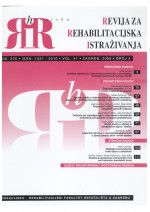Način života u obitelji iz perspektive djece i mladih
The way of life in family from the perspective of children and youth
Author(s): Ivana Jeđud Borić, Dubravka MarušićSubject(s): Family and social welfare
Published by: Sveučilište u Zagrebu, Edukacijsko-rehabilitacijski fakultet
Keywords: self-report; children/youth; family; way of life; qualitative methodology;
Summary/Abstract: 40 children and youth in the age between 12 to 20 years old, all in the process of need assessment and planning of intervention (institutional diagnosis and living community) were interviewed as a part of the scientific project “Social-pedagogical diagnosis”. The goal was: through active participation and self-report of young people, to get insight into the topics which young people define as currently important for their lives. Semi-structured interview was conducted with children/ youth, based on social-pedagogic areas (self, family, school, peers and leisure time, behavior disorders, intervention, future). In this paper authors discuss everyday life in family (usual day in family, common activities of family members, rules in the family) through perspective and interpretation of children and youth. Family is a primary environment for socialization and upbringing of children, and for that reason is one of the important areas of social-pedagogic work. Everyday life in family, its’ structure and regulations, can influence child’s behavior and the development of unacceptable behavior. The authors are interested in the way children and youth perceive everyday life in family, their insights into and understanding of different aspects of family life. Results have shown that children and young people, when talking about everyday life in family, in most cases talk about everyday routine activities (duties in household, help in some specific activities). Common activities of family members, such as games, travel and festivities were mentioned in less extant. One can also see lack of organization and non-structured way of spending the usual day. Structure of the day is left to children/ youth themselves or it comes from external factors (school). On the other hand, there is a lack of structure that comes from the family itself. Qualitative methodology was used for data analysis, and all data is saved and processed using NVivo programme for qualitative analysis of text.
Journal: Hrvatska revija za rehabilitacijska istraživanja
- Issue Year: 40/2005
- Issue No: 2
- Page Range: 71-85
- Page Count: 15
- Language: Croatian

